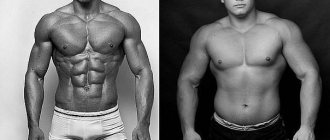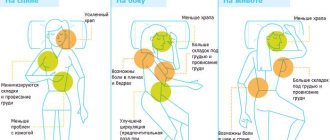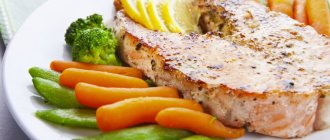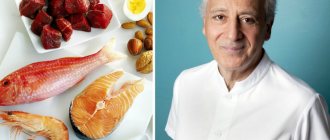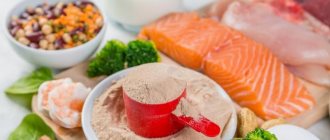The 20/4 diet, a form of intermittent fasting, became popular after the publication of Ori Holfmekler's book The Warrior Diet. It is known that Roman legionnaires and Spartans adhered to this food system.
The main advantage of this diet is its simplicity. You don't have to count calories and waste time preparing complex dishes. So, let's look at the basic rules, a sample diet menu, the process of addiction and the effect.
Basic Intermittent Fasting Patterns
The main intermittent fasting schemes are several of the most common options:
- 16/8,
- 20/4,
- 24 hours of fasting
- 36/12,
- random meals.
Let's look at these intermittent fasting eating patterns in more detail.
Scheme 16/8
The 16/8 plan involves 16 hours of fasting and 8 hours of eating. This is a fairly common version of intermittent fasting for mass gain, used in practice by many modern athletes.
According to this scheme, the most optimal time of hunger is considered to be the time period from 21 pm to 1 pm. After one o'clock in the afternoon and before nine o'clock in the evening it is recommended to eat food at least 2-3 times.
This principle of fasting includes a mandatory morning workout on an empty stomach (before 13:00), during which you are allowed to consume 10 grams of BCAA amino acids.
The first meal after training should be the largest and richest in healthy complex carbohydrates. Subsequent meals should be reduced in volume and amount of carbohydrates and end exactly at 21:00 in the evening of the same day. The scheme is then repeated daily.
20/4 or Warrior Diet
This 20-hour fast and 4-hour eating pattern is a more advanced intermittent fasting pattern. It received the name “Warrior Diet”, thanks to the book of the same name by Ori Hofmekler, where the author describes in detail the principles and features of this diet.
This nutritional principle involves avoiding eating for 20 consecutive hours every day. During this period, it is advisable to completely limit food intake, with the exception of light vegetables and some protein foods.
Evening training should precede a meal and take place on an empty stomach. It is recommended to eat within 4 hours, as a rule, this is one full evening meal or two medium ones. But in this case, no restrictions are imposed on the quantity and quality of food. The warrior diet involves a hearty dinner made from absolutely any food of your choice.
24-hour fasting pattern
The 24-hour fasting scheme, 1-2 times a week, is the most common among athletes who adhere to a low-carbohydrate and at the same time high-protein diet, since the lack of food during the day 1-2 times a week should be compensated by eating more protein foods on days with meals.
To achieve optimal results, this eating plan limits the consumption of simple carbohydrates and processed foods.
Scheme 36/12
The 36/12 schedule includes 36 hours of fasting and 12 hours of eating. According to this scheme, meals occur every other day. For example, on Monday, meals are distributed from 8 a.m. to 8 p.m. Then there was no food all night and all Tuesday. You can eat again between 8 a.m. and 8 p.m. on Wednesday.
During the “food window” periods, the food entering the body should be as healthy as possible and balanced in terms of the ratio of proteins, fats, carbohydrates and calories. However, several times a week you can allow yourself to eat whatever you want. This diet plan is the most difficult to follow and is rarely used by beginners.
Random meal plan
Random eating involves skipping meals throughout the day in a completely random order. Proponents of this intermittent fasting scheme suggest eating and exercising regardless of any diet, based only on your own feelings and instincts.
However, the daily diet in this diet plan should be based on the paleo diet principle, which, in turn, imposes certain restrictions on the consumption of certain foods. Eating protein foods, vegetables, fruits, berries, nuts and seeds is allowed. The calorie content of the diet is not limited. However, in accordance with this diet plan, you should skip one of the meals several times a week.
Sample menu for one day
You can create your own diet menu. A variety of natural foods are allowed, including homemade baked goods and pasta.
At the same time, purchased confectionery products should be used in limited quantities. It is important to remember that sweet foods are produced on an industrial scale. Their chemical structure includes a large amount of sugars, synthetic preservatives, dyes and trans fats. These compounds impair the digestion of food and prevent the normal absorption of nutrients needed by the body.
Scheme of the appearance of a feeling of satiety.
Ori Hofmekler in the book describes a technique by which you can determine when a feeling of satiety occurs. Signals about stomach filling arrive with a delay. In most cases, when the food center in the brain receives nerve impulses, a person begins to feel heaviness in the stomach and it becomes difficult for him to move. To avoid uncontrolled overeating, the author recommends not drinking liquid while eating. If you become very thirsty while eating food, you should finish the meal.
An approximate daily diet can be compiled as follows:
- in the morning, immediately after waking up, you should drink fruit juice or tea with lemon;
- After exercise, it is recommended to drink a protein shake;
- During the day, it is allowed to use still mineral water, herbal infusions or green tea without sugar.
Dinner can last from 7 to 11 pm. During this period of time, the following products and dishes are allowed to be consumed:
- baked meat, vegetable salad of tomatoes, cucumbers and boiled chicken eggs, vegetables with brown rice;
- cereal porridge with fruit or curd and berry mass;
- vegetable soup;
- nuts and dried fruits.
If a person is not prepared and it is difficult for him to adhere to such a diet, at the initial stage of diet therapy he should eat fresh vegetables or fruits as a snack. Snack portions should be gradually reduced each day. Thanks to this eating technique, the body adapts to the warrior diet, and the risk of side effects is reduced.
Contraindications to fasting
Intermittent fasting is absolutely not suitable for several categories of people, namely:
- pregnant women,
- nursing mothers,
- people with digestive disorders.
Intermittent fasting for weight loss is difficult to tolerate for men with a percentage of subcutaneous fat of more than 15, and for women with a percentage of subcutaneous fat of more than 22. For such people, other methods of eating for the purpose of losing weight will be most acceptable.
This option for organizing meals cannot be considered a complete alternative to a healthy diet, as it can negatively affect your health. This way of eating is suitable for reducing excess body weight only if you carefully select an individual intermittent fasting scheme.
Men tolerate intermittent fasting more easily than women. Intermittent fasting can cause serious harm to a woman’s hormonal background. It is better for women to choose more gentle intermittent fasting regimens for weight loss, or to completely abandon this diet in favor of a regular healthy diet with physical activity.
Sample menu
Photo source: pixabay.com
Option #1
First meal: cottage cheese casserole, seafood salad
Second meal: cream of celery soup , whole grain bread with a piece of cheese
Option No. 2
First meal: steamed fish, buckwheat, glass of kefir
Second meal: vegetable salad , chicken fillet, brown rice
ABC RECOMMENDS
Safe Fat Loss - 1200 Calorie Diet
Principles of Intermittent Fasting
This diet, like all the others, has its own principles for organizing the nutritional scheme and diet. Let's look at the most important of them.
Focus on personal needs
Numerous studies support the benefits of intermittent fasting. However, depending on the individual needs of a particular person (fat burning, maintaining muscle corset, prevention and treatment of diseases), the number of hours of fasting and nutrition may vary.
At the moment, scientists are conducting research in this area, and it is possible that in 10 years we will get an optimal fasting scheme that will bring us closer to the desired result in the shortest possible time. But today it would be much more correct to use an approach to intermittent fasting from the point of view of your own needs, goals and feelings.
Individual approach to choosing a scheme
Even if the technique involves fasting every other day for 36 hours, it is not at all necessary to strictly follow these recommendations. It is possible that one 36-hour fast per week will be sufficient for you. Especially if you are actively training or are in any stressful situation (for example, getting sick).
Distribution of periods of fasting and eating
Many proponents of intermittent fasting claim that a longer fast of about 36-40 hours has a more positive effect on the body than short periods without food.
But not everything is as simple as it seems at first glance.
Too long breaks in nutrition can have an extremely negative impact on the quality and health of muscle mass, as well as on a person’s performance, leading to a deficiency of vitamins and microelements in the body.
Therefore, athletes interested in good physical shape choose not very long periods (16-20 hours) of fasting, followed by training and eating within 4-8 hours after it. This approach provides the following advantages:
- Firstly, strength training on an empty stomach can lead to the artificial creation in the body of a state characteristic of a long period of fasting.
- Secondly, eating immediately after training promotes the most complete absorption of nutrients, vitamins and microelements, which, in turn, leads to better muscle recovery.
You shouldn’t get hung up on one fasting plan if it doesn’t suit you at all. Try another option or take a short time out. The main thing is to keep a common sense approach.
https://youtu.be/W6_lrex814I
Potential harms of the Warrior Diet
Despite the potential health benefits of the Warrior Diet, there are some problems that this way of eating can cause.
Some people find it difficult to stick to this diet
One of the most obvious limitations of the Warrior Diet is that it limits the time you can eat main meals to a four-hour period.
You may find it difficult to stick to this eating routine, especially if you participate in regular social events such as social breakfasts or lunches.
While some people may feel great eating very few calories over a 20-hour period, others may find that this way of eating is not ideal for their lifestyle.
The Warrior Diet Isn't Suitable for Many People
The Warrior Diet is not a way of eating that all people should follow.
This type of intermittent fasting is unacceptable for many people, including:
- Children
- Women who are pregnant or breastfeeding
- People with medical conditions such as type 1 diabetes, heart failure, or certain types of cancer
- Extreme athletes
- People with eating disorders or people who have had eating disorders in the past
- People who are underweight
In fact, some studies suggest that intermittent fasting may affect women's hormones more than men's (, ).
Some women can do intermittent fasting without negative effects. However, some may experience unpleasant side effects such as insomnia, anxiety, irregular periods and reproductive health problems.
The Warrior Diet May Lead to Eating Disorders
The Warrior Diet focuses on overeating, which can cause problems for many people.
Although Ori Hofmekler states that you should stop eating "when you feel pleasantly satisfied," this may not translate into healthy eating practices for everyone.
The Warrior Diet may lead to uncontrollable binge eating and conscious purging of the stomach through induced vomiting, especially in people at risk of developing an eating disorder.
Eating large amounts of food disorderly can also lead to feelings of regret and shame, which can negatively impact mental health and body image.
The Warrior Diet May Cause Negative Side Effects
The Warrior Diet may cause side effects, some of which can be serious.
Potential side effects include ():
- Fatigue
- Dizziness
- Low energy level
- Anxiety
- Insomnia
- Very strong hunger
- Low blood sugar (hypoglycemia)
- Constipation
- Fainting
- Irritability
- Hormonal imbalance
- Weight gain
Additionally, many health experts argue that people on the Warrior Diet are unable to obtain enough nutrients while doing intermittent fasting.
However, with proper dietary planning and a diet that includes only healthy, nutrient-dense foods, nutrient and calorie needs can be met.
Summary:
The Warrior Diet is not suitable for many people, as people may find it difficult to stick to this eating plan. Plus, it can lead to negative side effects such as fatigue, insomnia, and hormonal imbalance.
Autophagy as a result of fasting
Speaking about periodic fasting as a process extremely beneficial for humans, one cannot fail to mention the main reason why hunger is so important and necessary for the human body - cellular autophagy.
In 2020, Japanese molecular biologist Yoshinori Ohsumi received the Nobel Prize in Medicine or Physiology for his discovery of the mechanism of cell autophagy. This phenomenon has been known in scientific circles since the 60s of the twentieth century, but it has been studied extremely superficially.
Dr. Ohsumi's research allowed us to look at the processes of autophagy in more detail and comprehensively, fully confirming the need for fasting in order to strengthen and heal the body at the cellular level. This event stirred up unprecedented public interest in the issue of intermittent and therapeutic fasting.
Autophagy is translated from Greek as “self-eating.” This is a process aimed at destroying protein and internal components (organelles) of the cell under conditions of nutrient deficiency in order to reuse them for energy.
Currently, there are three types of autophagy:
- microautophagy,
- macroautophagy,
- chaperone autophagy.
Microautophagy
Microautophagy is aimed at capturing macromolecules and fragments of cellular structures by lysosomes (cell organelles with an acidic environment, responsible for the digestion process in the cell). This process is activated by protein digestion under conditions of energy or building material deficiency in the cell. However, the process of cellular microautophagy is highly indiscriminate and can occur under normal conditions – outside of nutrient deprivation. For example, there are known cases of partial microautophagy of the cell nucleus in yeast without loss of cell viability.
Macroautophagy
The process of macroautophagy occurs as follows. Part of the cytoplasm containing some of the cell's organelles is separated by a double cell membrane and forms an autophagosome. Autophagosomes then combine with lysosomes and are digested inside the cell. Thanks to this process, the cell gets rid of obsolete or damaged organelles.
Chaperone autophagy
Chaperone autophagy occurs as a result of stress, for example, during prolonged fasting or increased physical activity. With this type of autophagy, partially destroyed protein enters the lysosome cavity and is digested there. This type of autophagy is characteristic only of mammals.
Thus, autophagy is a natural way of ridding cells of unnecessary and “obsolete” organelles, as well as a means of renewing the body as a whole.
Results of practical experiments
In order to better introduce and familiarize readers with the system of intermittent fasting, we present data from practical experiments conducted by Dr. John M. Berardi, Drs. Christy Scott-Dixon and Nate Green using a real male participant aged 37 years, height 173 cm and weight 86 kg , with a body fat percentage of 10%.
His athletic results: bench press - 160 kg, deadlift - 205 kg, vertical jump - 81 cm, run 36.6 meters - 4.9 seconds.
The subject's goals were:
- improving your speed and strength performance,
- getting rid of 6-9 kg of body weight (mainly due to fat deposits),
- preservation of muscle mass,
- improving overall health.
It should be noted that the subject is a healthy man, a fitness trainer, with 20 years of experience in proper nutrition and training.
Experiment #1: 36-hour fast once a week
At this stage of the experiment, fasting was carried out once a week - on Sunday.
On weekdays from Monday to Friday, the calorie content of the diet decreased by 500 kcal from the usual diet and amounted to 2500 kcal per day. On Saturday, the calorie content of the diet increased sharply and was practically not limited (about 5000-6000 kcal for 5 meals). But before each meal, the subject performed 100 push-ups, since he believed that the pectoral muscles lag behind other muscle groups in development.
During the week (from Monday to Friday), the diet consisted of only protein and low-carbohydrate foods: meat, fish, vegetables, legumes, nuts. Every day, the subject took 1 tablet of multivitamins, 4000 IU of vitamin D, 1 tablespoon of fish oil and 10 grams of BCAAs before training.
On Saturday, the subject ate foods rich in carbohydrates without any special restrictions and stopped eating at 22:00 until 10:00 am on Monday (36 hours of fasting).
The subject trained 5 times a week according to the following scheme:
| Day of the week | Type of load | Duration of training |
| Monday | upper body strength training | 45 minutes |
| Tuesday | running (sprints) | 10 minutes |
| Wednesday | upper body circuit training | 45 minutes |
| Thursday | running (sprints) | 10 minutes |
| Friday | lower body strength training | 45 minutes |
Over 8 weeks, the experiment participant lost 5.5 kg in weight. The first 2 kg were lost in the first week, then the body lost mostly fluid. Further, weight loss stabilized at 500-900 grams per week.
About 60% of the lost body weight was fat, 40% was dry mass, but the subject, based on his own condition and strength indicators, is inclined to the version that 40% of the mass is water, since a large amount of protein consumed for 6 days a week, was sufficient to maintain muscle mass. Strength indicators have not changed. The subject's weight was 81 kg.
conclusions
- A 36-hour fast once a week brings good results, but weight loss occurs at the same rate as with a low-calorie diet.
- My health and overall fitness were better than with a regular low-calorie diet.
- Overall body composition, strength and speed indicators have improved.
Experiment #2: Fasting 2 days a week
The next experiment with fasting 2 days a week was carried out immediately after the first. Since the weight loss had noticeably decreased, the fasting program required more drastic measures.
Typically, when the weight loss process slows down, it is recommended to increase physical activity by 30 minutes a day, or reduce the total calorie content of the daily diet by 200 kcal.
But in order to continue the research, a more radical path was chosen - 2 fasting days a week.
The diet and training regimens remained the same, the only change was that the subject now fasted on Wednesday and Sunday.
This fasting/eating regimen led to the loss of another 3.5 kg of body weight, 2 kg of which was muscle mass. The experiment participant felt extremely exhausted and weakened. Body weight was 77.5 kg.
Next, it was decided to revise the fasting scheme and add a high-calorie meal on Tuesday (5000 kcal per day) before the fast on Wednesday (5000 kcal per day) for up to 22 hours with 100 push-ups before each meal.
Body weight did not change, but stabilized at the level of 77.5 kg. Nevertheless, his health improved, but his tolerance to days without food became worse - the subject was constantly waiting for high-calorie days.
conclusions
- The 2-day fasting scheme was not subjectively suitable for our participant in the experiment.
- If the 1 fast day per week regimen has stopped producing results, do not change your fasting regimen abruptly or make radical changes. It is possible that increasing low-intensity physical activity (such as walking or slow running) by 30 minutes a day will produce good results.
Experiment No. 3: 16/8 fasting
Every day the subject fasted from 21:00 in the evening until 13:00 the next day. At the same time, he got up at 8 a.m., then at 9 and 11 a.m. he drank green tea, and at 12 p.m. he trained (during which he was allowed to consume 10 grams of BCAAs). At 13:30, 16:30 and 20:30 – the subject ate food. Before each meal – 100 push-ups. And from 21 pm I was starving.
The training scheme generally remained the same. The total daily calorie content on Monday and Friday was 3200 kcal. And on other days – 2200 kcal. On days with low physical activity, the participants were expected to eat a low-carbohydrate diet.
During the first 4 weeks, the subject’s body weight increased by 2 kg and amounted to 79.5 kg. A general assessment of the physique allowed us to conclude that the main gain came from the muscles, since due to the increased consumption of carbohydrates (compared to the previous scheme), the muscles were filled with glycogen and water.
However, in the first two weeks, all signs of deterioration were observed: constant bouts of hunger, low mental concentration, mood swings in the first half of the day (up to 13 hours). Sometimes after waking up and before the training itself (from 8 am to 1 pm), the subject could not concentrate on his work, and sometimes his speech became very slow, excessive irritability appeared over trifles and an inadequate reaction to harmless comments. This led to the conclusion that there was a loss of emotional stability during the first two weeks of intermittent fasting.
Two weeks before the start of the first stage of this experiment, the emotional state and general well-being improved and stabilized. The new lifestyle and diet no longer created inconvenience for the subject. Moreover, the subject began to notice a certain muscle fullness (although his body weight increased by no more than 2 kilograms), and his body began to look more athletic compared to the previous two weeks after the start of the experiment.
conclusions
- The subject was suitable for the intermittent fasting scheme - 16/8, but with minor individual adjustments.
- The first 2 weeks of adaptation of the experiment were especially difficult.
- Well-being worsened when body weight was below 77.5 kg, and the body began to reduce the level of physical daily activity, apathy towards training and general fatigue were felt.
- In the future, it is advisable for the subject to adhere to a daily caloric intake of 2500 kcal. On days with intense training, you can consume up to 3200 kcal.
General results of the study
Summarizing the overall result of the study using different intermittent fasting schemes, we get the following result:
- The body weight of the subject at the end of the experiment was 78 kg (i.e., decreased by 8 kg).
- The percentage of subcutaneous fat is 6% (decreased by 4%).
- The weight remained for 4 months in the range of 77-78.5 kg.
- Testosterone level – 23.8 mmol/l (decreased by 5 units).
- Thyrotropin level is 1.21 mlU/l (decreased by 0.4 units).
- Hemoglobin level – 140 g/l (decreased by 14 units).
- The number of red blood cells, white blood cells and platelets in the blood has decreased.
- Total blood lipid levels (total cholesterol, triglycerides, and low- and high-density lipids) increased. This is a negative consequence that could well be caused by increased consumption of meat and fatty foods on fast-food days along with reduced carbohydrate intake. To prevent this phenomenon, more fresh vegetables and fiber should be added to the diet and the amount of fatty foods should be reduced.
- The total level of thyrotropin and testosterone in the blood remained within normal limits, but decreased. This decrease is typical for men following a low-calorie, carbohydrate-deficient diet.
Warrior Diet[edit | edit code]
Warrior Diet
– not just another newfangled trend in dietetics.
This is a modern concept of “combat” nutrition, based on many years of historical and biochemical research of its creator, Ori Hofmekler
. The Warrior Diet is all about eating one meal a day, preferably in the evening, without restricting calories or macronutrients.
A former Israeli special forces soldier became interested in the phenomenon of the incredible endurance of Roman legionnaires, who spent many hours of grueling training and battles. The result of many years of study of military history, modern physiology and biochemistry was an effective, scientifically based nutrition system, which, after careful testing, was adopted by the Israeli army.
In 2002, Ori Hofmekler’s book “The Warrior Diet” was published, which became a bestseller and received numerous rave reviews. However, there are also reviews like “the system does not work.” Yes, the warrior diet is aimed primarily at the overall health of the body, the fight against excess weight, increasing energy, developing endurance and functional strength. It can only be of interest to bodybuilders in terms of “drying”. However, a thoughtful creative approach, and not blindly following the system, will allow you to build impressive muscle volumes and improve strength indicators.
Bodybuilder Michael Keck from Kentucky, a medalist in many national amateur tournaments, came to powerlifting with the firm intention of setting a world or, at the very least, a national record. But the results were weak, and Mike decided to try out the increasingly popular new power system. To everyone's amazement, at a competition held by the International Powerlifting Association, Mike took first place, setting a new Association record in eventing.
MM: How did you come up with the idea for the Warrior Diet?
OK: I wasn’t really looking for this idea, it came to me on its own. This was back in the days when I worked in the Israeli special forces. I noticed that some of my friends, and myself, felt much better and performed better when we reduced our eating during the day during periods of high activity and ate in the evening when we could relax and unwind. I felt much better than the traditional army diet, which left me with low energy levels where my brain couldn't focus on the tasks I had to do. When you get used to eating several times a day, you become a slave to this habit. I felt a huge difference in my energy levels when I drastically reduced the amount of food I ate throughout the day. Later, when I was at university and starting my career as an artist, I discovered that by minimizing my food intake throughout the day, my creativity increased. Additionally, I was able to control my weight without much effort. After some research, I discovered that many warriors of the past adhered to a similar concept of nutrition, that's when I was really intrigued.
Later, when I began writing about the Warrior Diet in magazines and broadcasting through interviews, I realized that I was not alone in this concept and that many other people thought in unison with me. Many men and women tell me that breakfast is the most important meal of the day. Unfortunately, people do what they hear rather than listen to their body's signals as it tries to guide them on the right path.
Michael Mahler: I think we've moved a long way away from that and don't think of eating as a holiday anymore. For us, food is something we take for granted because we eat so often.
Ori Hofmekler: Nutrition is a way to relieve anxiety, especially the consumption of carbohydrates, which have become a real drug. People eat out of anxiety, end up feeling sleepy and low in energy, and then take coffee or other stimulants to perk them up.
MM: Why is it that we should not eat large amounts of food during the day when we are active? And why should we take large amounts of food at night when we are not active?
OK: First of all, let me point out that your body is not a machine. Never listen to those who tell you that your body is a machine. This man is either a fool or a liar. Your body is not a machine, your metabolism is so complex that not a single person in the world is capable of creating a machine that could imitate the human metabolism. Your metabolism is the secret to eternal life. This means that you recreate your body every day, month, year. No machine invented by man can do this. You don't need fuel to produce energy. Your body has huge sources of energy from fat reserves and from the disposal of dead tissue. I call this natural anabolism.
MM: I wonder what it is?
OH: When you avoid eating large amounts of food throughout the day and your sympathetic nervous system is dominant, your body produces a lot more energy. Energy production depends on more than just the food we eat. It depends on the state of our hormonal levels, the proper functioning of the endocrine glands and the balance of neurotransmitters. All this is regulated by the sympathetic nervous system, thus the production of growth hormone and other hormones is higher. You will produce much more energy than when you eat constantly throughout the day. Human health is a balance between energy production and use. This is the reason why many people suffer from excess weight. If you suffer from obesity, then you definitely have problems with energy utilization. If you use your energy reserves correctly, you will avoid obesity. Activate your sympathetic nervous system during the day, feed your brain, and celebrate your parasympathetic nervous system before bed.
MM: Okay, let's get back to anabolism.
OK: Currently, the way to activate anabolism is to eat 6 times a day, consume tons of protein, which will build muscle. This process can have terrible side effects. Bodybuilders typically have an off-season and a performance season. In the off-season, they consume tons of food, creating an excess of nutrients, and when preparing for tournaments, they try to get rid of all the excess that they have acquired by this time. Digestive problems are just some of the side effects of this whole process. But, as paradoxical as it may sound, in order to achieve an anabolic state, you need to limit yourself in food. When you undereat for 10-16 hours, the body receives a powerful stimulus to increase anabolism. In addition, if you do everything correctly, then after a period of food restriction, your body's ability to absorb protein increases by 160%!
MM: So what about the common belief that if you skip a meal, your body will store more fat as a reserve?
OK: This is a wrong opinion. In fact, after a period of short-term starvation, anabolism becomes the dominant process. This is exactly how our distant ancestors lived. Your body does not stand still, even if you do nothing. 50% is at its peak right now, 25% is growing right now and 25% is dying. This is what most people don't understand. In order to get a better composition of muscles, skin, bones, it is necessary to reduce the percentage of dying cells in the tissues. Not eating is a great way to do this, as it gives your body the opportunity to recycle its dead cells. During this period, your body will process diseased cells, tumors, etc. to create new tissue. This will help you not only maintain your youth, but also become much stronger and slimmer. You will have a much better body composition compared to people who eat non-stop.
MM: Very interesting, and this probably partly explains the fact that we see a lot of big bodybuilders who, despite their large size, lack strength.
OH: Correct. The Warrior Diet will give you something that no other diet will give you and help you achieve an optimal anabolic state. You'll enjoy your food more, your muscles will recover better, and you'll be able to detoxify your body every day, resulting in a longer life. In addition, you will have beautiful, elastic skin and better muscle composition.
MM: You say that following the Warrior Diet increases the rate of protein absorption by 160%. Does this mean that we end up being able to consume significantly less protein?
Oh yeah. In one of his latest articles, Dan Ducan stated that to maintain muscle mass, 50-70 grams of protein per day is enough for him. Eating a lot of protein is a marketing gimmick. Do you really think you need hundreds of grams of protein per day?
MM: I agree with you and I believe that people consume too much protein. You recommend eating raw fruits and vegetables throughout the day. Should they also be taken during the evening meal?
Oh yeah. However, it will be much healthier if they are cooked in combination with meat dishes. The benefit of cooked vegetables is that they release a lot of flavones and healthy fiber. A great example is mushrooms, which are the best source of polysaccharides and dietary fiber. The only way to get all these nutrients from mushrooms is to cook them.
MM: One interesting thing I've noticed is that when you eat the Warrior Diet style, you instinctively begin to eat exactly the foods your body needs during the overeating phase.
OK: Yes, that's true. When you are really hungry at the end of the day, your body begins to tell you what it really needs, you begin to clearly feel what exactly you want to eat now.
MM: What other benefits does the Warrior Diet have?
OH: The benefits go far beyond just physical and mental health. Those who follow the principles of the Warrior Diet will be able to adapt to various types of stress much more easily compared to other people. There are various life situations when food actually becomes unavailable. The Warrior Diet will prepare you for these types of situations, and you will be able to endure them painlessly.
MM: Can you give me examples of people who have been able to build big muscles by following the principles of the Warrior Diet?
OK: That's a good question. I can give myself as an example. Over the past year I have been able to gain 6kg without any change in my body fat level. It is 5-6%, and I can maintain this figure without effort. I am over 50 years old and my weight is about 77 kg. But more importantly, I feel very strong and my explosiveness has improved significantly recently. My face looks slimmer and better than ever. I receive emails from people who have lost excess fat and gained muscle at the same time. However, the Warrior Diet can never be a bodybuilding diet. It is intended for those who want to always be in great shape and feel good. If your goal is to build muscle, this can be achieved with the Warrior Diet, but it won't be a quick process. The main advantage will be that your weight will not experience sharp fluctuations, and you will avoid many health risks.
MM: So the Warrior Diet is for people who want to be lean and strong?
OK: This is what a real warrior needs first of all – to have functional strength. Excessively hypertrophied quadriceps will only be a hindrance in a combat situation. The ability to run fast is the most important quality for a warrior; large hips will only hinder him. Also, do not forget that women are more attracted to slender men with an athletic build, rather than hippo-shaped bodybuilders.
MM: So the Warrior Diet is not for huge bodybuilders and those who strive for huge muscle mass?
Oh no. But keep in mind that I have nothing against bodybuilders, some of my close friends are bodybuilders. Being huge is their choice and I respect it. The Warrior Diet gives you an alternative path to getting big while still having functional strength.
Michael Mahler: I worked with Pavel Tsatsouline, the author of the book “Power to the People” (in Russian translation known as “Get Stronger”, translator’s note) and tried many of his ideas in my practice and in preparing my clients. He emphasizes in his book that functional strength and the central nervous system are much more important than muscle size.
Ori Hofmekler: I absolutely agree with that. I love doing functional training.
MM: What do you mean by that?
OH: You're putting yourself through intense cardio, like 15-20 minutes of running or other aerobic activity, which will seriously deplete your energy reserves. Immediately after this, you begin weight training. I noticed that the stress of running was seriously reducing my leg press performance. After running, I can never lift the weights I usually lift. But what I call functional training improves my ability to deal with unexpected situations that may arise in my life.
MM: Can you give me an example of functional training in the bench press?
Oh no. I know many people want to increase their bench results. You are unlikely to need it in life, unless you are going to be raped by a 150-pound female hippopotamus (laughs). Why else do you need a big bench press?
MM: (laughs). It is truly incredible if this could ever happen to you and you would have to use force in such a situation.
OK: Right. And when you look at real fighters, including boxers and martial artists, they don't have huge pecs. Exercises like military presses, squats, deadlifts, and kettlebell swings are much more functional.
MM: I agree. I have a degree in religious studies and would like to make a very interesting point about the diet of an organization called the Nation of Islam. Former leader of the Nation of Islam, Elijah Muhammad, recommended a diet very similar to the Warrior Diet. Each member of the organization must drink only water during the day, but in the evening they have the right to enjoy food with their families. They practice this for many reasons, including mental and physical, so they have mental clarity throughout the day. I believe that Malcolm X (Islamic spiritual leader, translator's note) correctly expressed that the most difficult thing for a person is not to control sexual desire, but to control the desire to eat. In addition, Malcolm X said that if you can control your hunger, then you can control everything else.
OK: The founder of Islam, the Prophet Mohammed, who came from a wild Mediterranean tribe, also had a very interesting approach. I would say that Muslim Ramadan imitates the way these ancient tribes used to survive. They don't eat, or at least don't eat much during the day. Today, many residents of the Middle East adhere to this lifestyle, and at the same time they have a physique like the Rock, for example, the same Arabs.
MM: I think people who experience restrictions will always be in better shape compared to people living a modern lifestyle.
OH: Exactly, Mike. But still, residents of modern cities who adhere to the principles of the “Warrior Diet” still have a chance to be strong and healthy. This requires some sacrifices, and you will not be the size of a steroid bodybuilder on this diet, this is a false image in any case. I am not a Christian, but in the New Testament Jesus states that it is necessary to have 2 meals a day, the third is from the evil one.
MM: Very interesting point.
OK: You already understand that I profess simple principles that are not difficult to follow. Your level of life satisfaction will be much higher. The “Warrior Diet” does not imply any dietary restrictions; you can eat whatever you want every day, all your favorite foods. Your body will tell you what it wants and needs, it's a pretty nice way to live.
MM: Is it possible to completely eliminate all meals during the day, except for the evening one?
OK: This is one of the methods, quite radical, but very effective. For most people, a lighter version of the Warrior Diet is suitable, where they can eat vegetables, fruits, or fruit and vegetable juices throughout the day. For what? Fruits and vegetables help detoxify the body, supply it with vitamins and minerals, and also alkalize it. They contain essential phytochemicals that have a beneficial effect on the functioning of the digestive system. You don't need to use a lot of them, and in your case, Mike, one carrot juice will be enough. If you want, you can take apples, kiwi or papaya. The sugar that is naturally found in these plants has a very low glycemic index.
MM: Which juices are better to drink – freshly squeezed using a juicer, or prepared in a blender with pieces of pulp?
OK: The main thing is that it is fresh fruit, not dried fruit. Use either a blender or a juicer. Personally, I use a juicer because juices taste better to me and too much fiber is hard on my gut. I try to minimize digestive processes during the day to maintain high mental performance. The brain is the most important part of the body. The brain burns 25% of your calories and should not be neglected.
MM: What I really like about the Warrior Diet is its focus on improving mental performance, something that no other diet out there addresses.
OK: Yes, your brain is the number one organ, it controls your every move. Your brain controls your mood and all processes in your body. Your brain should always be at its peak. Caffeine is also allowed in moderation as it improves brain function. The amino acid tyrosine can also be very beneficial.
MM: Do you recommend eating organic produce and meat? (Organic products are agricultural products grown without the use of pesticides and other chemicals, translator’s note).
OH: Yes, organic foods are ideal and best for you. However, don't worry if you don't always have the opportunity to eat them.
Advice for athletes
Don't exceed your overall stress level.
Any diet, and especially hunger, is a serious physiological stress for the body. Try to take into account the general level of stress during fasting due to illness, everyday problems and training - without exceeding acceptable limits. If you feel unwell physically or mentally, just rest and skip the workout.
If fasting gives good results, do not overdo it.
Try to keep fasting periods manageable, short, and intermittent. Do not practice intermittent fasting for more than 4-5 months. Be sure to take breaks.
Make your workouts easier.
If you follow a fasting scheme with a restriction of the total calorie intake on days with meals, your body experiences an acute energy deficit, so training during this period should be carried out in a gentle manner.
- Strength training – no more than 3-4 hours per week.
- Interval (circuit) training – no more than 2-3 short sessions per week.
- Cardio training (only if necessary) – no more than 1-2 hours per week.
Find the optimal combination.
In contrast, long-term, low-intensity training pairs well with many intermittent fasting regimens. If you want to qualitatively transform your body and reduce the amount of subcutaneous fat, you need to increase the amount of daily physical activity.
Don't be fooled!
Don't expect to lose weight if you just skip breakfast and eat as usual the rest of the time. Intermittent fasting is complete control over the consumption of nutrients (proteins, fats, carbohydrates), careful selection of foods and mandatory training on an empty stomach.
Attention CrossFitters: You should pay special attention to the use of intermittent fasting for weight loss or mass gain. Since high-intensity training to develop endurance and strength is completely incompatible with fasting and can harm the body!
Scientific facts[edit | edit code]
Extension of youth[edit | edit code]
In this regard, the Warrior Diet is superior to many of the famous diets. “Nutritional stress, such as intermittent fasting, undereating or calorie restriction, can extend the life of all living organisms, from bacteria to humans,” says Ori Hofmekler. “Aging and many diseases are associated with one mechanism in the body—the mammalian chain of rapamycin (mTOR).”
mTOR is a protein that regulates cell growth, proliferation (tissue growth through cell multiplication) and survival. In a young body, this protein promotes development and maturation. In the adult body, mTOR promotes accelerated aging, the development of diabetes and cancer.
“mTOR can actually kill you,” says Hofmekler. “It is an unfavorable growth factor in a non-growing organism.” Research published in the International Journal of Cancer found that blocking the mTOR signaling pathway is a potent anticancer agent. It has also been established that eating food activates mTOR, while lack of food suppresses it. In this study, scientists concluded that mTOR inhibition has a positive effect on the health of the cardiovascular system, prevents the development of cancer, increases the body's resistance to infection and, ultimately, helps to prolong life.
Increasing insulin sensitivity[edit | edit code]
Insulin is one of the most important hormones in the human body; it is involved in the processes of muscle growth and fat burning. High sensitivity to insulin improves the ability to digest carbohydrates, improves protein synthesis and promotes fat burning, while low sensitivity to this hormone creates problems such as obesity and type II diabetes. “High insulin sensitivity is the number 1 factor for maximizing muscle growth with minimal food,” explains Hofmekler. “By following the principles of the Warrior Diet during periods of short-term fasting, you will help improve your body's sensitivity to insulin.”
Accelerating muscle growth and fat burning[edit | edit code]
By increasing your insulin sensitivity, you'll burn more fat, even without cutting calories. Researchers at Louisiana State University found that short periods of fasting improve fat oxidation. Participants who restricted themselves to food during the day, but ate heavily in the evening, showed an average reduction in fat levels of 4% over 22 days. This study also refutes the common myth that evening overeating contributes to obesity.
Growth hormone (GH, somatotropin) is a powerful stimulator of bone and muscle tissue growth, as well as a powerful stimulator of fat burning. Peak production of this hormone occurs at night. Providing the body with ample amounts of nutrients helps this hormone work as efficiently as possible. Additionally, fasting during the day also stimulates the secretion of GH.
Author: Andris Broks
Hormonal reactions of the body to diet
As a practical experiment has shown, periodic fasting affects not only fat deposits, but also the entire body as a whole. Accordingly, it also affects hormonal levels.
When switching to fasting according to the scheme of two fasting days a week, a decrease in the production of sex hormones may be observed: testosterone, DHEA (dehydroepiandrosterone), LH ( luteinizing hormone), FSH ( follicle-stimulating hormone).
Impact on men
For a man, such a change in hormonal levels is fraught with sudden mood swings, constant fatigue, a decrease in the level of performance, muscle loss and a general loss of energy. But after restoring the previous high-calorie diet with plenty of protein and fat, the hormonal levels quickly recovered.
Impact on women
For the female body, periodic fasting (for two or more days a week) in combination with physical activity can cause much more significant damage to hormonal levels.
In general, the female body reacts more sensitively to changes in nutrition. Therefore, women should have a very intelligent approach to diet and training. In one experiment, a 35-year-old woman who fasted for two days a week, combined with intense training and high levels of general stress, experienced a sharp decline in her overall hormonal levels. Levels of estrogen, progesterone, DHEA (dehydroepiandrosterone), LH/FSH (luteinizing/follicle stimulating hormone) were practically zero. My periods have stopped. The restoration of hormonal levels in the participant in the experiment was very slow.
Therefore, in healthy people with normal hormonal levels, periodic fasting should be used very carefully and thoughtfully, and the periods of hunger themselves should be short (up to 16-20 hours).
Intermittent fasting may be beneficial for people with insulin sensitivity problems and certain other hormonal problems, especially polycystic ovary syndrome in women and excessive testosterone aromatization in men.
Who shouldn't try intermittent fasting for weight loss?
Fasting - however, like all other relatively strict and strict systems of food restriction - is better not to practice for the following diagnoses and conditions:
- 20% or more underweight.
- Diabetes mellitus type I.
- Toxic goiter.
- Severe heart disease - node blockade, failure, post-infarction condition.
- Chronic hypotension (when fasting, it is fraught with fainting).
- Gallstones, peptic ulcer.
- High level of platelets in the blood.
- Hepatitis.
- Tuberculosis.
- Pregnancy and breastfeeding.
Popular articles for weight loss and health
Vegetarian Breakfast: Recipes
Low glycemic index foods list for weight loss
Fiber-rich foods list for weight loss
Products that increase testosterone in men after 55 years
If the listed diseases and conditions are not observed, but doubts still prevail, then before trying a new calorie restriction regimen, you should consult with your physician.
